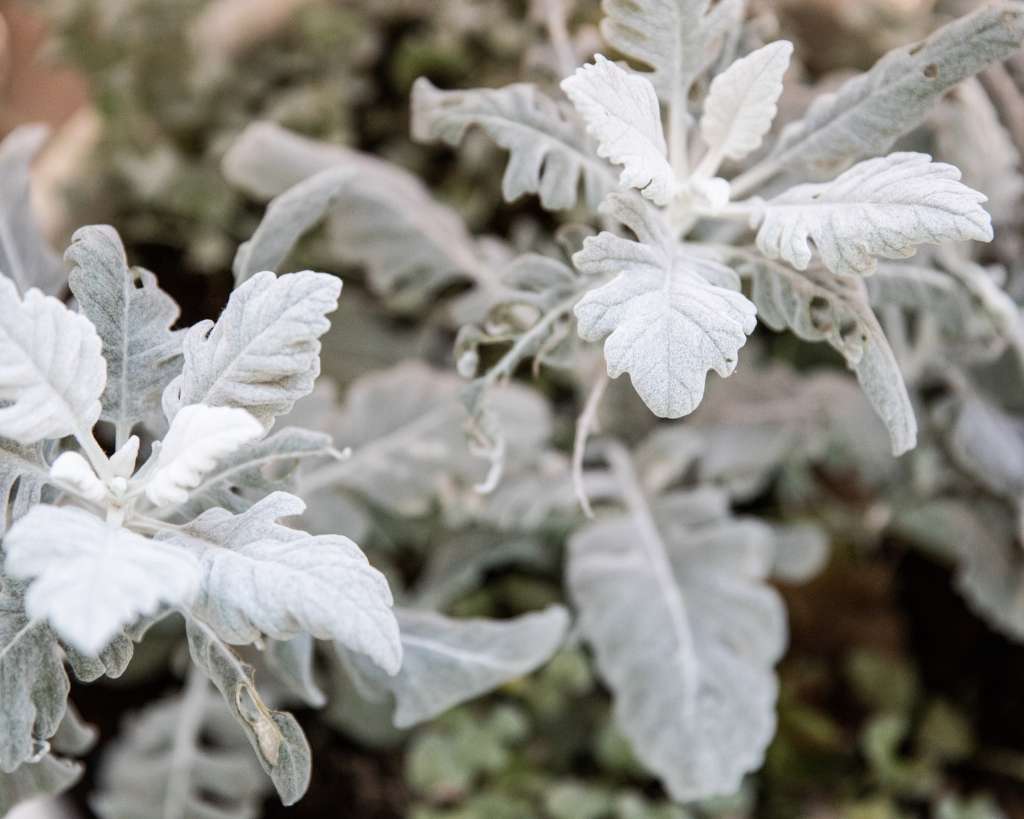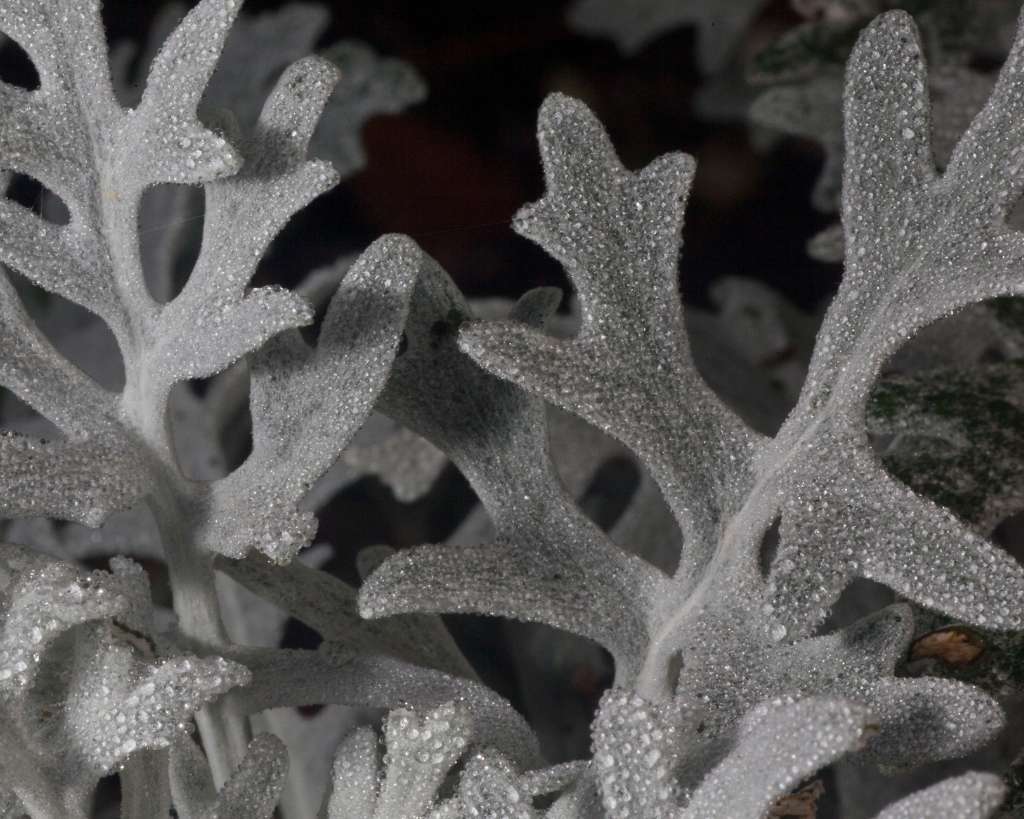Dusty Miller has dozens of varieties, which can be overwhelming for gardeners. To help you out, we’ve selected the best dusty miller varieties you can plant in your garden.
Here is a quick overview of different types of dusty miller plants:
- Angel Wings
- Silver Lace
- Silverado
- New Look
- Silver Dust
- Ramparts
- Silver Filigree
- White Diamond
Angel Wings
| Type | Perennial |
| Height | 1 ft |
| Spread | 2 ft |
| USDA Zones | 9 to 11 |
| Light Requirements | Full-Sun to Partial Shade |
Senecio Angel Wings is a stunning variety of dusty miller, prized for its large, silver-white leaves with a unique, feather-like texture. The leaves of this plant are soft and fuzzy, providing a delicate and elegant appearance. Senecio Angel Wings is an excellent choice for adding contrast and texture to garden beds, borders, and container plantings.
This plant is a low-maintenance and drought-tolerant perennial, making it an ideal choice for gardeners looking for an easy-to-care-for plant. It is also deer-resistant, making it an excellent option for gardens where deer are prevalent.
Senecio Angel Wings prefers well-draining soil and full sun to partial shade, although it can tolerate some shade in hotter climates. This plant typically reaches a height of 12 to 18 inches, with a spread of 18 to 24 inches. It is an excellent choice for adding texture and contrast to mixed borders, and it pairs well with various other plants, including annuals and perennials.
Senecio Angel Wings leaves’ velvety texture is a bit different than the fuzzy texture of dusty miller (Senecio cineraria). Moreover, the leaves of Senecio Angel Wings are larger than those of dusty miller (Senecio cineraria).
Overall, Senecio Angel Wings is a beautiful and versatile plant that will add elegance to any garden or container planting. Its unique, feather-like texture and low-maintenance nature make it an excellent choice for gardeners of all skill levels.
Silver Lace

| Type | Perennial |
| Height | 1 ft |
| Spread | 2 ft |
| USDA Zones | 7-10 |
| Light Requirements | Full-Sun to Partial Shade |
Silver lace(Centaurea cineraria) is a common variety of Dusty Miller, which has a lacy or fern-like foliage with finely cut, silver-gray leaves that are deeply lobed and have a delicate texture. This variety is also more compact and tends to grow to a height of around 8-12 inches.
In contrast, other varieties of dusty millers, such as cirrus and new look, have broader and flatter leaves with a more silvery color. They may also grow taller, up to 2-3 feet, and have a more sprawling habit.
The silver-gray foliage of the silver lace is its most distinctive feature, making it a popular choice for gardens, landscapes, and containers. It is often used as a border plant, accent plant, or filler plant and can be combined with a wide range of other plants to create stunning displays.
Despite its delicate appearance, silver lace is a tough plant that can tolerate various growing conditions, including poor soil, drought, and heat. It is easy to care for and requires minimal maintenance, making it an excellent choice for novice and experienced gardeners.
Silverado
| Type | Perennial |
| Height | 2 ft |
| Spread | 2 ft |
| USDA Zones | 8 to 10 |
| Light Requirements | Full-Sun to Partial Shade |
Cineraria (Dusty Miller) maritima Silverado is a stunning variety of dusty millers known for its striking silver-gray foliage. Its deeply lobed leaves have a fuzzy texture that gives them a unique appearance and makes them stand out in any garden or landscape design.
Silverado has a more compact and upright growth habit than other dusty miller varieties, making it an excellent choice for use in borders, edging, or as a filler plant. Its leaves are also larger and more deeply lobed than other varieties, which gives it a more dramatic and eye-catching appearance.
Another advantage of Silverado is that it is more heat and drought-tolerant than many other dusty miller varieties, which makes it an excellent choice for use in hot and dry climates. It also tends to have a longer blooming season than other dusty millers, which means that it can provide visual interest in the garden for a more extended period of time.
In terms of care, Silverado is relatively low-maintenance and easy to grow. It prefers well-drained soil and full sun to partial shade. Regular watering and occasional fertilization can help it to thrive.
New Look

| Type | Perennial |
| Height | 1.5 ft |
| Spread | 1.5 ft |
| USDA Zones | 7-10 |
| Light Requirements | Full-Sun to Partial Shade |
Dusty Miller ‘New Look’ is a hybrid variety of dusty miller prized for its striking silvery-gray foliage with serrated edges. It is a cross between several different Senecio species, including Senecio cineraria, and is known for its larger and broader leaves compared to other dusty miller varieties.
It can be used in various landscaping ideas such as rock gardens, woodland gardens, containers, and borders. Like most dusty miller varieties, New Look doesn’t require rigorous maintenance. It is easy to grow and requires well-drained soil, full sun to partial shade, and regular watering to prosper.
The best companion plants to grow with this variety are Dracaena, Petunia, and Allium.
Silver Dust

| Type | Perennial |
| Height | 1.5 ft |
| Spread | 2 ft |
| USDA Zones | 7-10 |
| Light Requirements | Full-Sun to Partial Shade |
Silver Dust is one of the best-known dusty miller varieties. Its silver-gray deeply lobed leaves look precisely similar to silver lace. Silver Dust leaves are slightly smaller than other dusty miller varieties, giving them a more delicate and airy appearance.
Silver Dust has a more compact and bushy growth habit, which makes it an excellent choice for use as a border or edging plant. The growing habits are almost similar to other dusty miller varieties mentioned in this article.
Lamb’s Ear, Marigold, and Salvia can be planted as companions with silver Dust.
Ramparts
| Type | Perennial |
| Height | 3 ft |
| Spread | 3 ft |
| USDA Zones | 7-10 |
| Light Requirements | Full-Sun to Partial Shade |
This variety is lesser known, but it is one of the easiest varieties to grow in your backyard. This variety is characterized by its finely dissected, silvery-gray foliage with a soft, velvety texture. It is a low-growing, mounding plant often used as an ornamental plant in gardens and landscapes.
Silver Filigree
The “Silver Filigree” variety of the dusty miller plant is named for its unique foliage, which has a delicate and intricate appearance, similar to the art of filigree. The soft and lacy appearance of the “Silver Filigree” plant’s leaves is reminiscent of this type of jewelry, which is why it was given this particular name.
This dusty miller variety is known for its compact size, making it an excellent choice for container gardening. This is particularly useful for gardeners with limited space or wanting to grow plants in smaller areas. Additionally, its smaller size makes it easier to maintain and care for than larger dusty miller varieties.
Another advantage of this variety is that it can be used in various landscaping designs, such as border plantings or as a ground cover. Its silvery foliage contrasts with other plants and can help create an eye-catching and unique look in any garden.
The growing habits of silver filigree are almost similar to other varieties mentioned in this article. It is a low-maintenance plant that grows well under challenging conditions. You can prune the plant throughout the growing season by snipping off any spent or damaged leaves.
White Diamond
| Type | Perennial |
| Height | 1 ft |
| Spread | 2 ft |
| USDA Zones | 7-10 |
| Light Requirements | Full-Sun to Partial Shade |
This variety of dusty miller is called ‘White Diamond’ because of its striking grayish-white color and the shape of its leaves. The leaves are deeply lobed and have a diamond-like shape, with each lobe resembling the facets of a diamond.
White Diamond is a compact perennial plant that typically grows to a height of 10 to 12 inches (25 to 30 cm) with a width of 12 to 14 inches (30 to 35 cm), while other dusty miller varieties can grow taller and wider.
It is a low maintenance plant that is tolerant of various growing conditions. It prefers full sun to partial shade and well-draining soil, but can tolerate dry or drought-like conditions. The plant is also deer-resistant and attracts pollinators, making it a popular choice for gardeners who want to create a low-maintenance, visually appealing landscape.
Which ones are the tallest and shortest among these varieties?
Ramparts are the tallest variety, and Angel Wings, Silver Lace, and White diamonds are the shortest.




